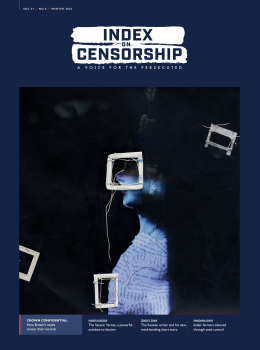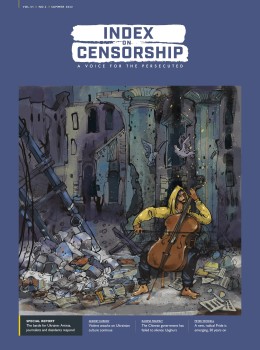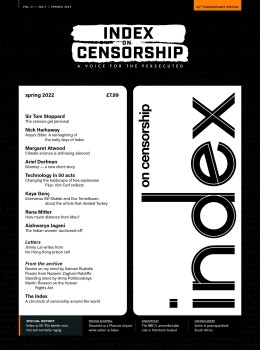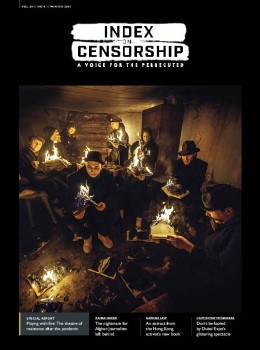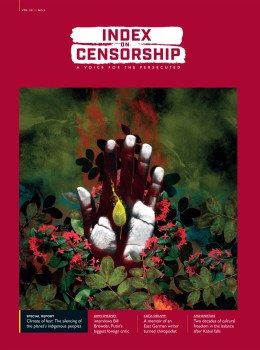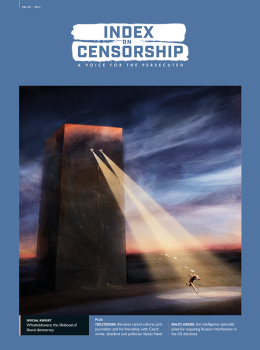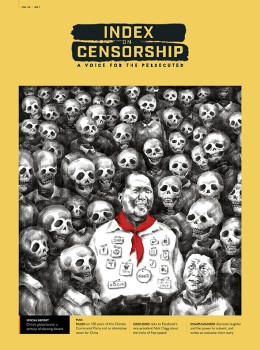UK authorities have announced an outright ban on The Human Centipede II (Full Sequence). But how do censors make these decisions? Murray Perkins is a film examiner who classifies hardcore porn. He spoke to Index on Censorship about what it takes to make the grade

In 2000, hard-core pornography became legal on video in the UK for the first time. Up until then, the R18 category — the BBFC classification for pornographic films, sold only in licensed sex shops — had been limited to the softer end of porn. But this watershed was not precipitated by a permissive government. On the contrary, and paradoxically, it came only after a fight by the Home Office to tighten up the BBFC R18 guidelines. Jack Straw, as Home Secretary, had been horrified to discover in the late nineties that the BBFC had relaxed these guidelines under the previous government, and he insisted that they be reinstated. The original changes had in fact been a result of pressure from the Metropolitan Police, who were concerned that by being able to sell only relatively soft porn at R18, the licensed sex shops were simply unable to compete with the illegal, black market sex shops thronging the Soho and King’s Cross areas. Straw was alerted to the BBFC changes by Customs, who had seized a film distributed by Purgatory Films in the summer of 1997, a film that the distributor claimed would have been awarded an R18 classification under the revised guidelines. A long fight followed, led by the film distributors Sheptonhurst and Prime Time Promotions. When, in 2000, the High Court ruled that seven films denied classification by the BBFC, as a result of the re-imposition of the old guidelines, (including the memorable titles Horny Catbabe and Nympho Nurse Nancy) should in fact be passed at R18, the Home Office was effectively forced to cave in, the BBFC once again liberalised its guidelines, and a whole new era of explicit sex on video and DVD in the UK was launched. Within a few years, the number of R18 videos being passed for classification leapt from 30 a year to over 1,000 a year.
Murray Perkins has been a senior examiner at the BBFC since May 2000, classifying 18 and R18 film and video. He discusses the material he views — some extremely violent and graphically obscene — in technical, unemotional and non-judgmental terms. This is, as he says himself, a mechanical and a professional process — he and his fellow examiners have to assess whether material meets the guidelines and is within the law. The detachment he brings to his work in order to make those judgments is evident in the manner in which he discusses his job. In a field that attracts such an extreme range of responses, it’s rare to encounter such a phlegmatic approach.
Index on Censorship: Have the BBFC guidelines for R18 films changed since 2000?
Murray Perkins: Not a great deal — they’re quite broad. A sex work shouldn’t be in breach of the criminal law; participants must be adults; it shouldn’t encourage an interest in sexually abusive activity — rape or child abuse; it should be consensual; there’s limited scope for role play; but it should be non-harmful and there shouldn’t be any infliction of pain beyond mild consensual activity. Strong sexual threats or abuse are unlikely to be acceptable.
Index: So it hasn’t had to be changed since the Criminal Justice and Immigration legislation on extreme pornography came in?
Murray Perkins: No, there’s nothing that would require us to change our current R18 guidelines. Our restrictions under the current guidelines ensure that sex works passed as R18 fall comfortably short of the kind of material that would be considered “extreme” under the new legislation. They’re also flexible enough to allow certain role play situations and fetish material, BDSM [bondage, domination, sado-masochism] material — they’re not so hardline that we’re relentlessly trimming everything back to the simplest of sex works. But I don’t think there’s anything in the R18 guidelines you’d want to take out — you don’t want to take out the requirement for material to be consensual for example — because consent is fundamentally important.
Index: So it combines all the legal concerns — whether it’s the Video Recording Act’s focus on harm, obscenity or sexual offences.
Murray Perkins: Yes I think it does — in broad terms. But there are a number of pieces of legislation that may come into play. As a brief bullet point list I think it does cover the basic tenets of the more important criteria that need to be considered. And of course the legislation is considered and referred to independent of the guidelines’ points as well, where it’s applicable. We also have all the policy behind us. The policy changes behind the guidelines — it’s not hugely fluid, but it’s more fluid, and it allows for more subtle amendments. If there’s a change in the privacy laws, for example, we incorporate that. So apart from a little bit of redrafting, the R18 guidelines themselves haven’t had any significant changes at all since 2000. But again the basic ideas of consent, being non-harmful, not focusing on pain or extremes of humiliation, dehumanisation or degradation — those sorts of underlying principles are always there.
Index: Can you give me an outline of some of the obscene activities that remain unacceptable in an R18 film?
Murray Perkins: There’s actually quite a range and we do take a steer from the Crown Prosecution Service and the Obscene Publications Unit [of the Metropolitan Police] on their interpretation of what would be likely to be found obscene — which is what they put forward for prosecution and what they get convictions on — acknowledging that in most cases they are going to get a guilty plea and forfeiture [under Section 3 of the Obscene Publications Act, material can be seized and forfeited by a magistrate without going to jury trial]. But it’s not uncommon for us to cut urolagnia [urination onto another person as sexual activity]; in fact it’s quite a common cut to a sex work. Another one which is perhaps less common is enemas — not the application itself, but interacting with the expelled fluid — and coprophagia [sex play with faeces]. Coprophagia videos are not hugely unusual — there are a number of works out there that would feature this sort of activity — but people don’t submit that to us as they know they wouldn’t get it classified for distribution. Blood sports is another category — that may be if a performer had their period for example and any kind of marked play with blood, as opposed to incidental unfocused sight of a limited amount of blood. Fisting is another quite common one I suppose. Bestiality and necrophilia would nowadays be caught by the Criminal Justice and Immigration legislation on extreme pornography, but it’s still obscene.
Index: You gave me an example of a German film Taxi zum Klo — which had an 18 certificate — where urination takes place in a sexual act. Can you explain to me why this act, which is seen as technically obscene, was acceptable in this film?
Murray Perkins: The key point is that it’s not a sex work. The test that we apply to sex works, as to whether a work is obscene or not, is not the same as applied to a non-sex work — so whereas in a sex work it would be very clear cut, in a non-sex work we would have to take a step back and consider whether the Obscene Publications Act would apply to something like that. At that point we can apply the public good test — and in a non-sex work there’s going to be a lot more scope for a public good argument, for artistic or literary grounds for example. And I think that Taxi zum Klo is a work where that’s quite a reasonable position to adopt.
Index: Is that quite a rare instance of an obscene act being passed in a film?
Murray Perkins: It is. Although I’m not sure that it’s unusual in that we passed it — it’s unusual as much because it’s not commonly submitted. So it’s not a question we have to ask very often.
Index: How many films have you rejected in their entirety on average?
Murray Perkins: Without defining a period of time it would be difficult for me to put an average on it — but it’s been single yearly figures for some time. In 2005 we rejected seven works — which included a batch of “how to” drugs videos, but in 2006 we rejected just one video. I’d say the average in recent years is two.
Index: There was the film Terrorists, Killers and Middle East Whackos that you did reject in 2005. Can you explain why that film was rejected?
Murray Perkins: Yes. It came to us as Terrorists, Killers and Other Whackos. I don’t know if they thought that if they took out “Middle East” it would be more acceptable. It was a compilation of very extreme images of real suffering, real death, and real mutilation — combined with elements that had a comic intent — put together with a jaunty soundtrack for entertainment purposes. In terms of a work which was likely to be harmful as much as obscene, it had a high potential to encourage a strong callous response in its likely audience. Is it potentially harmful to society? I think encouraging callousness with that type of material, if it’s not [harmful] I’m not sure what would be.
Index: You’re talking about harm — which is something the BBFC has had to take into account since the Video Recordings Act [1984]. So that is one of your considerations across the whole of the BBFC — and in classifying R18 films. Was it rejected as harmful or as obscene?
Murray Perkins: I believe we cited both. It’s not unusual where a film could be found to be in breach of either Act that we would reject it under both — citing the Video Recordings Act and the Obscene Publications Act. Looking at the actual rejection letter, we cited the potential for the work to deaden the sensitivity of viewers to pain and suffering and to impair the moral development of younger viewers in particular. [Quoting from letter to distributor] “The Board also considers that the work also raises serious concerns about possible breach of the Obscene Publications Act [OPA].”
Subsequently it was convicted under the OPA. We’re obviously obliged not to classify material that might be in breach of the criminal law. Under the Video Recordings Act, the question of harm that might be caused to potential viewers, we concluded that the video might be harmful because of the influence it might have on the attitudes and behaviour of at least some intended or potential viewers. [Quoting from letter to distributor] “By presenting actual death, mutilation and suffering as entertainment, the work in the Board’s view has the potential to desensitise viewers and perhaps even to incite some harm to others . . . given the rapid pace, the MTV style of editing, the addition of inappropriate music, the supposedly amusing captions, the work appears calculated to appeal to young or impressionable persons or may have a significant brutalising impact on their attitude to human work or pain.” [The distributor was prosecuted and received a nine-month sentence.]
Index: It seems to be not what one would normally consider obscene — obscenity normally involves sex. I’m interested that something that is clearly a work of extreme violence can be prosecuted under the OPA.
Murray Perkins: It is the only one that I’m aware of.
Index: The only instance of one that is pure violence?
Murray Perkins: My knowledge of the history of prosecutions under the OPA is by no means encyclopaedic, but so far as I’m aware it’s unusual.
Index: It suggests that maybe there isn’t another law that the police can use for prosecutions in such cases. Because the moral effect on the viewer is so much the test of the OPA — whether it “depraves and corrupts” — and clearly from your summary there, depraving and corrupting is clearly a concern.
Murray Perkins: In terms of the test — “deprave and corrupt” and the moral issues — I’m not sure that the OPA is inappropriately applied. It seems quite reasonable an application of that test to a work like this. Not least because it doesn’t have any of the qualities that you would point to in terms of public good — none of the defences under the OPA would seem to come into play. I can’t think of any reason why you wouldn’t apply the OPA test. In many respects, the way the violence is portrayed isn’t so far removed from a pornographic presentation as well. There’s no narrative, there’s no thesis.
Index: What’s the impact on you of having to watch these kinds of things? Do you keep yourself detached? Do you still get quite upset?
Murray Perkins: I think all examiners will have moments where you do get upset about the things you have to see. It’s not pleasant stuff, it’s not nice to watch. There’s a certain element of detachment, because you’re also engaged in a mechanical process of recording what you’re watching for the report — so you have to get the issues down to form the basis of the argument as to whether it should be passed or cut or banned outright or what sort of category it should get. So there is that mechanical, slightly detached professional process. But at the same time we’re all human, so when you see things that are really quite nasty, it’s going to have an impact and you might want to take a bit of time out.
Index: Whatever one may think of the test “deprave and corrupt”, that is still the law and the examiners are all human — are they harmed, are they corrupted by what they’re looking at? How does an examiner protect themselves?
Murray Perkins: It’s a good question. It’s the same question about desensitisation — do examiners become desensitised over time? It’s a combination of factors really. There’s quite a substantial difference between the job of an examiner who’s viewing a collection of works on any given day over five hours which can range from something like Terrorists to the Teletubbies. It’s a very different viewing context to somebody who has a mate or two around or is sitting by themselves in a chair at home putting the DVD on for their own entertainment. We’re having to watch it because it’s our job, having to make notes, having to think about the case for whatever recommendation we’re going to make for the work we’ve viewed. I think that element of detachment is a form of protection for examiners, as well as the possibility to talk to your fellow examiners immediately after your viewing and discuss the things you’ve seen.
Index: Are there other cases of films that have been rejected and prosecuted since you’ve been at the BBFC? Or is this exceptional?
Murray Perkins: In my experience — in my time with the BBFC — it’s exceptional. There aren’t any others that we’ve rejected that have been prosecuted.
Index: Can you tell me about others that you’ve rejected entirely? Is it because they’re full of urolagnia?
Murray Perkins: No, we haven’t rejected any films because of that — although we have cut a lot. There was a work called Struggle in Bondage which, from start to finish, featured women fully bound and gagged in various states of undress, usually on the floor, and struggling and whimpering as the camera panned around slowly. There was no context, we don’t see them being bound, there’s no dialogue or negotiation or any element or suggestion of consent. So there’s nothing to say, okay this is a consensual role play, this is a woman who likes to be tied up and this is part of the game. None of those mitigating factors — it’s just a bound and gagged woman. So that was rejected — there were consent issues, issues of harm. I don’t want to give too much thought to what people get out of something like that — it looks to me like a video of people who have been abducted. Other rejects have been on grounds of encouragement of drugs — how-to guides to growing drugs and processing them. Again, it pretty clearly falls foul of encouraging criminal acts.
Index: Do you think our perception of what is obscene has changed? Obviously in terms of what is acceptable in an R18 film, that has changed, but has the wider concept of what is obscene changed at all?
Murray Perkins: I’ve no doubt it has over time, looking at the type of material that has been subject to challenge under the OPA over the years.
Index: What about in the time you’ve been here at the BBFC?
Murray Perkins: I would say no. We’ve had pretty consistent information from the Obscene Publications Unit on what’s been put forward [for prosecution]. There’s been surprisingly little shift. Perhaps if you’d asked me five years ago if I thought one or two things might change, I might have thought that they would have.
Index: Such as?
Murray Perkins: For example, the kind of arguably less harmful sexual behaviour — such as urination during sex. I might have thought that would have shifted.
Index: What would it take for that to shift — for a jury not to convict?
Murray Perkins: Yes — it would require for these cases to go before a jury and for the jury not to convict them and for that to happen probably more than once or twice.
Index: But very few cases come before a jury.
Murray Perkins: Because people take the guilty rap and forfeiture — and let it lie at that.
Index: Do you feel on that basis that the Obscene Publications Act needs reviewing?
Murray Perkins: I’ve thought about that at various times. I’m probably more comfortable with the way it works now than I was a few years ago. I think it’s still flexible enough that if the material changes and attitudes change the law doesn’t need to — the law can bend with the attitudes of a jury. And I think when you’ve got an overarching piece of legislation like the OPA — which has at its heart an interest in morals and public good and the corruption of morals — they’re quite broad concepts. It would be very difficult to pin those down to something that was much more prescriptive. I think having those broad tests allows the interpretation over time.
Index: But at the same time you have a very prescriptive check list.
Murray Perkins: Yes, we do.
Index: So you’re very clear about what is in and what is out.
Murray Perkins: Perhaps that seems at odds — but then our checklist isn’t the law. Our checklist is a reflection of current interpretation. So it can change with time. The fact that it hasn’t really changed in the last eight years I don’t think suggests that the legislation is inflexible — it’s simply a reflection of standards. The fact is that whenever things actually have gone to jury, urolagnia for example, it’s only reinforced the position that is currently held.
Index: Have any gone to jury since you’ve been here?
Murray Perkins: There’ve been some cases — involving urolagnia. I do believe there was one a few years ago that was not guilty, but around the same time there was another that was guilty. Different juries, different parts of the country. Different works as well, of course.
Index: Can you think of an example that has been problematic to you in making a decision?
Murray Perkins: Really only on technical points. Taxi zum Klo wasn’t the most difficult of decisions — it had challenging scenes and had it been a couple of years earlier I suspect it would have taken us that much longer to reach a decision, given it also had some real sex as well. But the real sex is generally a little easier for us to deal with now. In terms of sex works and urolagnia it tends to be just technical — did the urine come into contact with another person or did it miss? Can we see it clearly? How many seconds constitutes a sufficient break between urination and sex? We have to think about these sorts of things, but they’re not difficult decisions in terms of testing the legislation itself.
Index: When you decide to let real sex pass in a film that’s an 18 film — is that a difficult decision?
Murray Perkins: It’s not as difficult as it was when we had no real precedent for doing it. In the Realm of the Senses — Ai No Corrida was the first example in the early nineties. But they were few and far between, including The Idiots [1998]. But since 2000, with films like Baise-moi, Nine Songs, Intimacy, Destricted, there’ve been many more precedents. More than 100 works have now been passed at 18 with some shots or scenes of explicit sex: non-sex works. Passing more doesn’t mean we’ve become hugely liberal and will pass it as soon as we see it. But it does mean that with that much precedent you know where you stand a little bit more and we know more about where the public stands.
Index: Have you ever seen an R18 that you think is a work of art — that you think — yes, there’s raw sex in every frame, but this is a great piece of film making.
Murray Perkins: That’s a very good question — if it were a genuine work of art would it be a sex work? It probably wouldn’t. If it’s a genuine work of art, is its primary purpose sexual arousal or is it intellectual stimulation? I think occasionally you might see something you’d joke about being art — but I don’t think I’ve ever seen a sex work that I would describe as a work of art. If it were a work of art I’d think it was something other than a sex work. That said, you do get sex works that have very high production values and a bigger budget than the average — arguably even some pretty respectable acting, good costumes, good camera work. But I don’t think they quite manage to achieve “work of art” status.

This article first published in “I Know It When I See It”, Index on Censorship magazine, volume 38, no 1 (2009). CLICK HERE TO SUBSCRIBE





